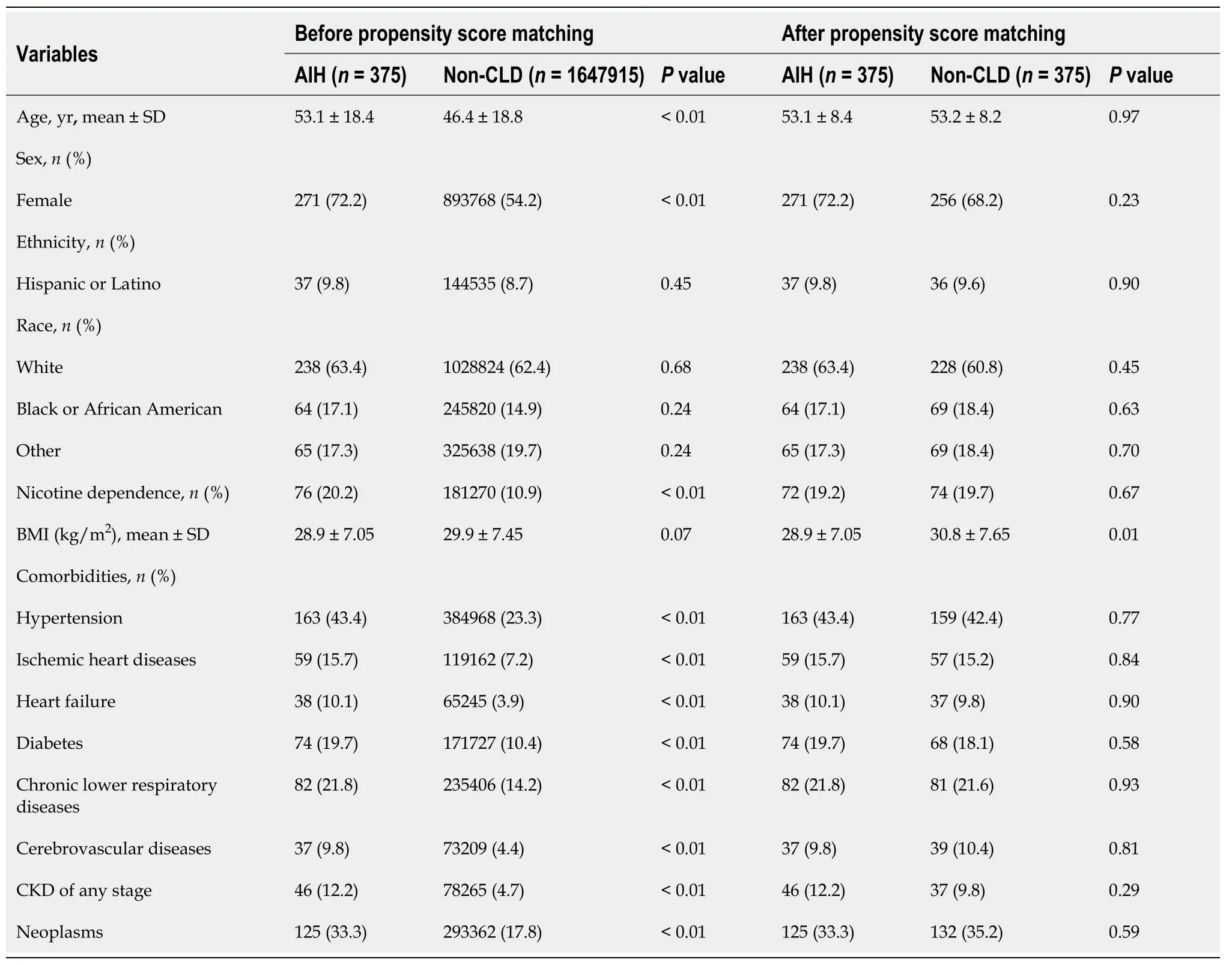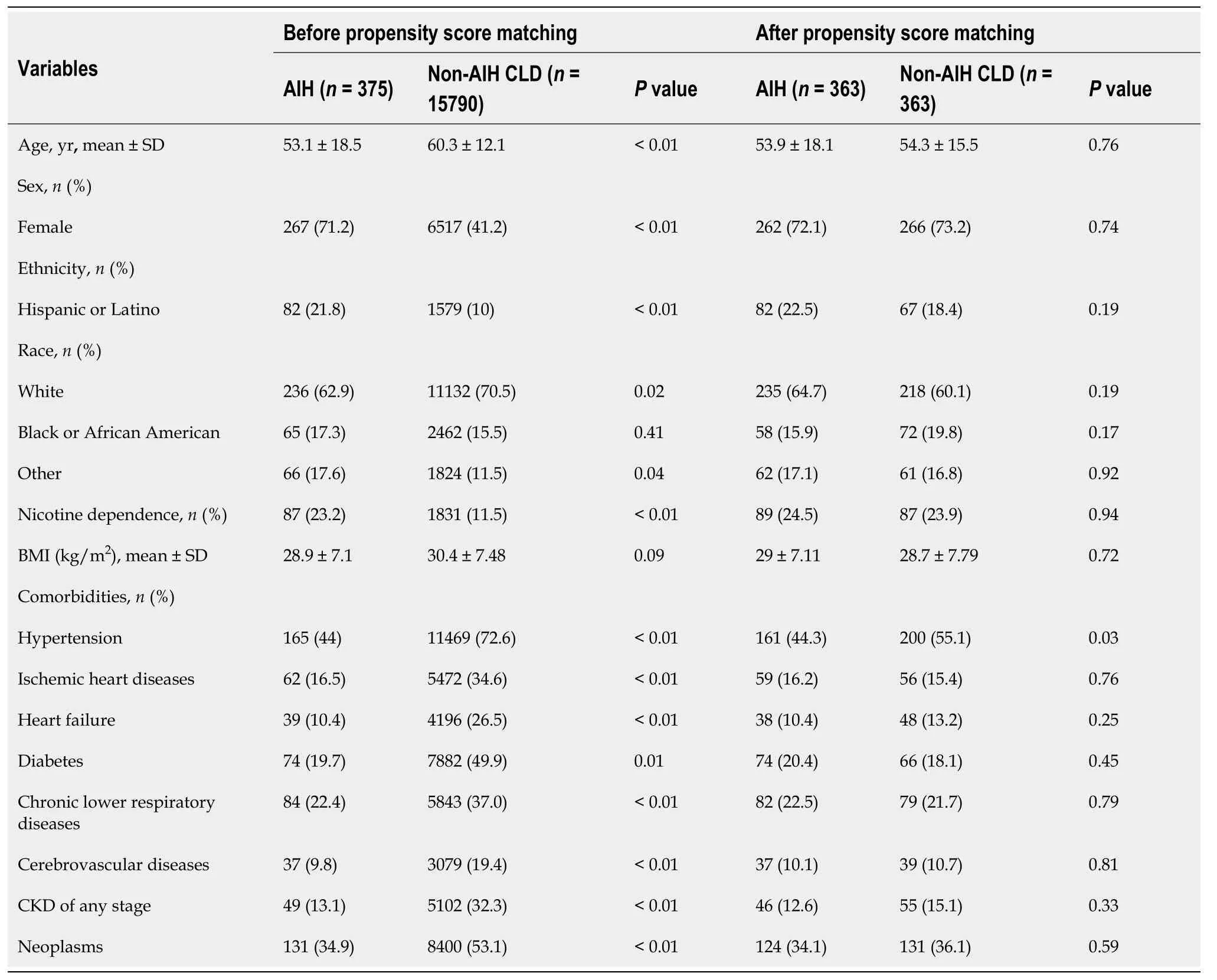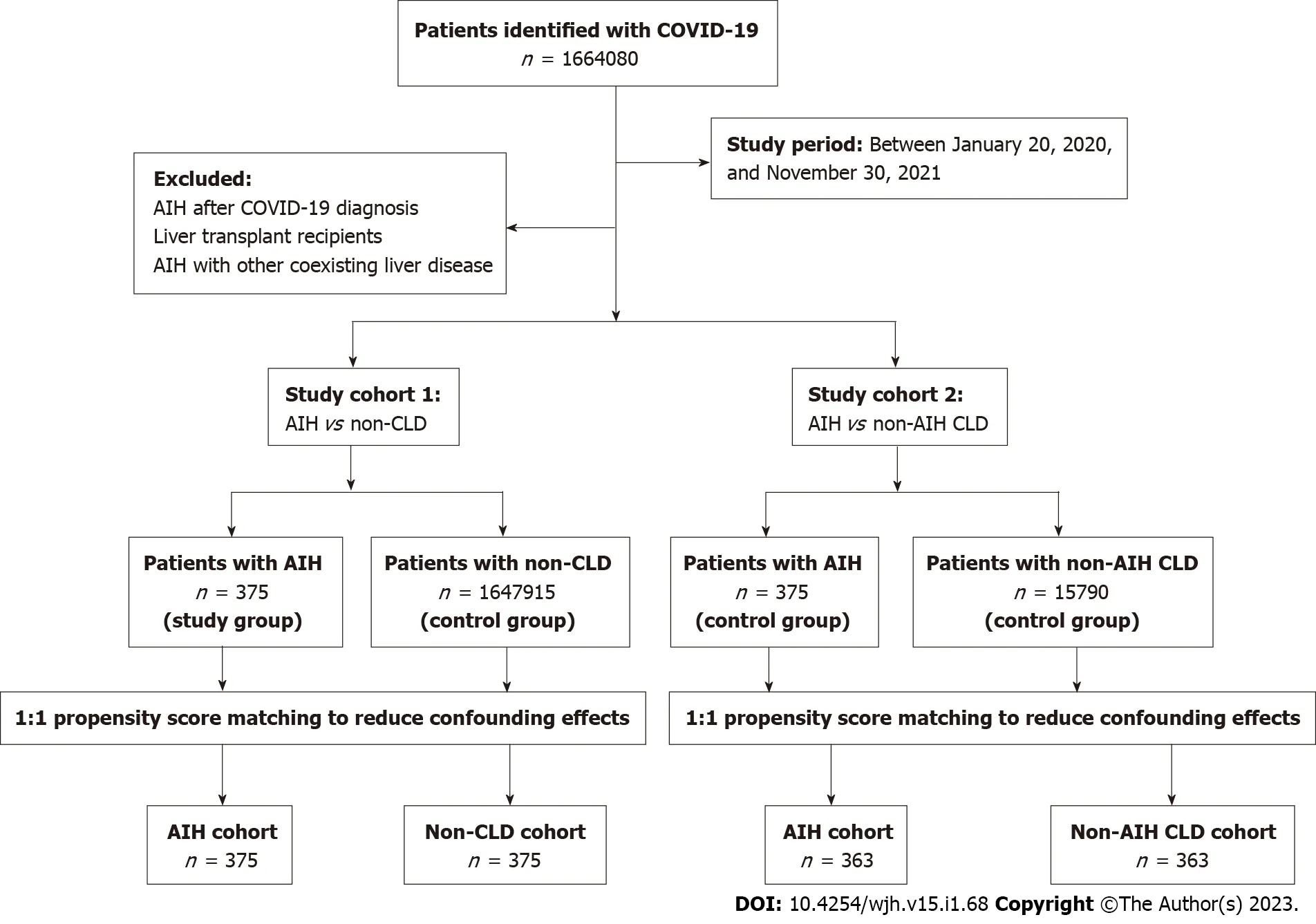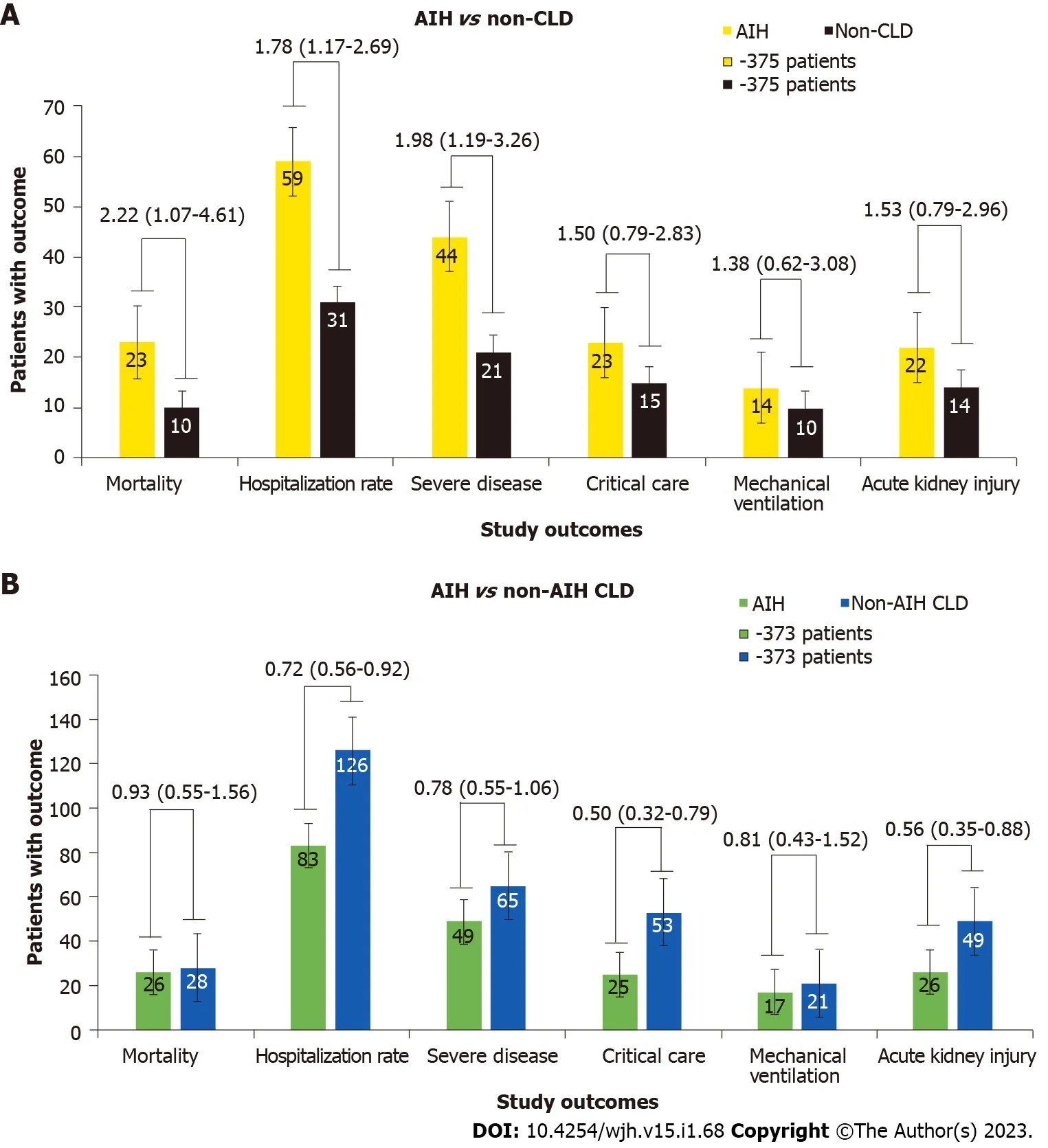Clinical characteristics and outcomes of COVID-19 in patients with autoimmune hepatitis: A population-based matched cohort study
2023-03-18ArunkumarKrishnanRuheePatelYousafBashirHadiDiptasreeMukherjeeSarahShabihShyamThakkarShailendraSinghTinsayWoretaSalehAlqahtani
Arunkumar Krishnan,Ruhee A Patel,Yousaf Bashir Hadi,Diptasree Mukherjee,Sarah Shabih,Shyam Thakkar,Shailendra Singh,Tinsay A Woreta,Saleh A Alqahtani
Arunkumar Krishnan,Ruhee A Patel,Yousaf Bashir Hadi,Sarah Shabih,Shyam Thakkar,Shailendra Singh,Section of Gastroenterology and Hepatology,West Virginia University School of Medicine,Morgantown,WV 26505,United States
Arunkumar Krishnan,Tinsay A Woreta,Saleh A Alqahtani,Division of Gastroenterology and Hepatology,Johns Hopkins University School of Medicine,Baltimore,MD 21287,United States
Diptasree Mukherjee,Department of Medicine,Apex Institute of Medical Science,Kolkata 700075,West Bengal,India
Saleh A Alqahtani,Liver Transplant Center,King Faisal Specialist Hospital and Research Center,Riyadh 12713,Saudi Arabia
Abstract BACKGROUND Patients with autoimmune hepatitis (AIH) require life-long immunosuppressive agents that may increase the risk of poor coronavirus disease 2019 (COVID-19)outcomes.There is a paucity of large data at the population level to assess whether patients with AIH have an increased risk of severe diseases.AIM To evaluate the impact of pre-existing AIH on the clinical outcomes of patients with COVID-19.METHODS We conducted a population-based,multicenter,propensity score-matched cohort study with consecutive adult patients (≥ 18 years) diagnosed with COVID-19 using the TriNeTx research network platform.The outcomes of patients with AIH(main group) were compared to a propensity score-matched cohort of patients: (1)Without chronic liver disease (CLD);and (2) Patients with CLD except AIH (non-AIH CLD) control groups.Each patient in the main group was matched to a patient in the control group using 1:1 propensity score matching to reduce confounding effects.The primary outcome was all-cause mortality,and secondary outcomes were hospitalization rate,need for critical care,severe disease,mechanical ventilation,and acute kidney injury (AKI).For each outcome,the risk ratio (RR) and confidence intervals (CI) were calculated to compare the association of AIH with the outcome.RESULTS We identified 375 patients with AIH,1647915 patients with non-CLD,and 15790 patients with non-AIH CLD with COVID-19 infection.Compared to non-CLD patients,the AIH cohort had an increased risk of all-cause mortality (RR = 2.22;95%CI: 1.07-4.61),hospitalization rate (RR = 1.78;95%CI: 1.17-2.69),and severe disease (RR = 1.98;95%CI: 1.19-3.26).The AIH cohort had a lower risk of hospitalization rate (RR = 0.72;95%CI: 0.56-0.92),critical care (RR = 0.50;95%CI: 0.32-0.79),and AKI (RR = 0.56;95%CI: 0.35-0.88) compared to the non-AIH CLD patients.CONCLUSION Patients with AIH are associated with increased hospitalization risk,severe disease,and all-cause mortality compared to patients without pre-existing CLD from the diagnosis of COVID-19.However,patients with AIH were not at risk for worse outcomes with COVID-19 than other causes of CLD.
Key Words: Autoimmune hepatitis;SARS-CoV-2;COVID-19;Mortality;Outcomes;Liver disease;Severe
INTRODUCTION
As coronavirus disease 2019 (COVID-19) cases increase in the United States and globally,investigators continue to identify risk factors for adverse outcomes resulting from COVID-19 infection.The known risk factors for severe disease include older age,male gender,and comorbidities such as hypertension,diabetes,chronic obstructive pulmonary disease,and chronic liver diseases (CLDs)[1-3].In addition,studies have shown that COVID-19 affects the liver,with over one-third of hospitalized COVID-19 patients presenting with abnormal liver function,which was also associated with a longer hospital stay[4,5].In contrast,a higher risk of mortality and hospitalization rates have been reported in COVID-19 patients with pre-existing liver disease compared to those without liver disease[6].
Autoimmune hepatitis (AIH) is a genetically predisposed CLD.The exact mechanism regarding its immune dysfunction has yet to be elucidated;however,an imbalance between effector and regulatory immunity and molecular mimicry may play a role in its pathogenesis[7].The prevalence rate of AIH in the United States is estimated to be 31.2/100000,which is similar to the prevalence rates reported in Europe[8].The association between severe acute respiratory disease coronavirus 2 (SARS-CoV-2) and autoimmune diseases is very complex and only partially understood.In addition,understanding the outcomes of COVID-19 infections in AIH patients is particularly important due to the fact that patients with AIH require lifelong immunosuppressive agents to prevent cirrhosis and end-stage liver disease,which may increase the risk of viral and bacterial infections[9,10].The clinical impact of the pre-existing use of immunosuppression in patients with COVID-19 remains complex and not clearly defined.Evidence is mixed regarding the impact of immunosuppressive agents on COVID-19 outcomes.Hence,existing data are controversial on the outcome following COVID-19 infection in patients with autoimmune diseases.Some studies have shown that long-term steroid use in the management of autoimmune conditions prior to COVID-19 diagnosis is associated with adverse outcomes such as hospitalization,intensive care unit (ICU) admission,and mortality[11,12].At the same time,other results did not support an increased risk of severe COVID-19[13,14].Thus,study results are inconsistent,with a high degree of heterogeneity.Therefore,a detailed understanding of the clinical course of COVID-19 in patients with AIH is necessary.
On the other hand,increasing vaccine uptake and other public health safety measures have helped reduce the pandemic’s burden.However,considerable morbidity and mortality continue to accrue among non-immune and unvaccinated individuals.Furthermore,previous AIH literature has used small samples of patients with AIH.To address these research gaps,we performed a large populationbased retrospective cohort study using data from the multicenter research network.Our analysis focused on evaluating AIH as an independent risk factor associated with severe diseases of SARS-CoV-2 and all-cause mortality.
MATERIALS AND METHODS
Study design
This population-based,multicenter,retrospective cohort study was conducted using TriNetX(Cambridge,MA,United States),a federated health research network data set.TriNetX is a multiinstitutional health research network that provides de-identified electronic medical records systems(EHRs) from the included healthcare organizations.Clinical variables (referred to as “facts” on the network) are derived directly through EHRs.Robust quality assurance on the network is achieved at the time of extraction before inclusion.The platform only provides aggregate patient counts and statistical summaries to ensure de-identification at all levels of retrieval and dissemination of patient data.TriNetX received a waiver from the Western institutional review board as a federated network since only aggregated counts and statistical summaries of de-identified information are included.No protected health information was obtained,and no study-specific activities were performed in the retrospective analyses.Details of the data source and quality checks are described in the supplementary data.
Study participants
All adult patients (age ≥ 18 years) with AIH and confirmed COVID-19 infection between January 20,2020,and November 30,2021,were included.The search criteria for potential patients with COVID-19 were based on specific COVID-19 diagnosis codes or positive laboratory confirmation of COVID-19.
To determine the clinical impact of AIH on clinical outcomes of COVID-19,we compared AIH patients to a control group of patients without any pre-existing CLD,including AIH (non-CLD) and COVID-19.To assess the impact of AIH compared to other liver diseases,we compared AIH patients to a control group of patients with other pre-existing CLD (non-AIH CLD) and COVID-19.Details of the search criteria and diagnosis codes used for patient selection are described in the supplementary data.
Matching process
Each patient in the main group was matched to a patient in the control group using 1:1 propensity score matching (PSM) to reduce confounding effects[15].Covariates in the propensity score model were adjusted for a priori-identified potential confounders: Age,sex,race/ethnicity (Hispanic,non-Hispanic white,non-Hispanic black,or non-Hispanic other),body mass index (BMI),nicotine dependence,and comorbidities that are listed in Table 1.Logistic regression on these input matrices was used to obtain propensity scores for each patient in both cohorts.Logistic regression was performed in Python 3.6.5(Python Software Foundation) using standard libraries NumPy and Sklearn.The same analyses were also performed in R 3.4.4 software (R Foundation for Statistical Computing,Vienna,Austria) to ensure outputs match.After calculating propensity scores,matching was performed using a greedy nearestneighbor matching algorithm with a caliper of 0.1 pooled standard deviations.The order of the rows in the covariate matrix can affect the nearest neighbor matching;therefore,the order of the rows in the matrix was randomized to eliminate this bias.
Study outcomes
The primary study outcome was all-cause mortality from index events within 60 d.The index event was defined as either the time of COVID-19 diagnosis or the first COVID-19 positive test result date,whichever occurred first.Secondary outcomes were hospitalization,severe diseases,acute kidney injury(AKI),and intensive care (requiring extracorporeal membrane oxygenation or mechanical ventilation) in the 30 d from COVID-19 diagnosis.Severe disease was operationalized and defined as a composite outcome requiring intensive care or death within 30 d of COVID-19 diagnosis.

Table 1 Baseline characteristics of patients with autoimmune hepatitis and non-chronic liver diseases patients with a positive test for severe acute respiratory syndrome coronavirus-2
Statistical analysis
All statistical analyses were performed in real-time using the TriNetX platform.Continuous variables are expressed as means ± SD.Categorical variables were defined as frequency and percentage.For each outcome,the risk ratio (RR) and confidence intervals (CI) were calculated to compare the association of the AIH with the outcome.Numbers were then validated by comparing them with the output from SAS version 9.4.A-priori-defined two-sided alpha of less than ≤ 0.05 was used for statistical significance,and all statistical data analyses were performed utilizing the form of the limitation in real-time.
RESULTS
Baseline characteristics
We identified 15790 non-AIH CLD and 1647915 non-CLD patients during the study period (Figure 1).Major etiologies of non-AIH CLD included alcoholic liver disease (n= 4159,26.3%),NAFLD (n= 3085,19.5%),viral hepatitis (n= 1093,6.9%),and other diseases of the liver (n= 3456,21.8%) (Supplementary Table 1).Baseline characteristics of non-CLD patients are described in Table 1.893768 (54.2%)were female,and 144535 (8.8%) were Hispanic or Latino.181270 (11%) reported nicotine dependence.Rates of several common comorbidities were significantly lower in the non-CLD group compared to the AIH cohort,including hypertension (n= 384968,23.3%),neoplasms (n= 293362,17.8%),and chronic lower respiratory diseases (n= 235406,14.2%).
Baseline characteristics of the non-AIH CLD patients are described in Table 2.6517 (41.2%) patients were female,and 1831 (11.5%) patients had a history of nicotine dependence.Compared to the AIH cohort,non-AIH CLD patients had higher rates of comorbidities,including hypertension (n= 11469,72.6%),neoplasms (n= 8400,53.1%),diabetes (n= 7882,49.9%),and chronic lower respiratory diseases (n= 5843,37.0%).

Table 2 Baseline characteristics of patients with autoimmune hepatitis and non-autoimmune hepatitis chronic liver diseases patients with a positive test for severe acute respiratory syndrome coronavirus-2
AIH characteristics
During the same study period,375 patients with AIH were identified.Baseline characteristics are described in Tables 1 and 2.A majority (n= 271,72.2%) of the patients were female,and 76 (20.2%)patients had a history of nicotine dependence.Common comorbidities were hypertension (n= 163,43.4%),neoplasms (n= 125,33.3%),chronic lower respiratory diseases (n= 82,21.8%),and diabetes (n=74,19.7%).Coexistence of other immune-mediated disorders in the AIH cohort occurred most often with systemic lupus erythematosus (n= 61,16.2%),rheumatoid arthritis (n= 57,15.2%),Sjögren syndrome (n= 45,12.0%),and ulcerative colitis (n= 27,7.2%) (Supplementary Table 2).The most common immunosuppressive agents used in the AIH cohort were prednisone (n= 313,83.4%),azathioprine (n= 170,45.3%),and budesonide (n= 80,21.3%) (Supplementary Table 2).
Clinical characteristics
Patients with AIH compared to non-CLD: Results of laboratory vitals,symptoms,and laboratory findings between AIH and non-CLD cohorts are presented in Supplementary Table 3.All liver function tests were significantly different between the AIH and non-CLD patients (P<0.01).After a propensity score-matched analysis,all liver function results remained significantly different between the cohorts:The mean alanine aminotransferase (ALT) (65.3vs23.6 U/L;P<0.01),aspartate aminotransferase (54.9vs23.7 U/L;P= 0.01),total bilirubin (0.86vs0.53 mg/dL;P= 0.01),and alkaline phosphatase (ALP)(105.0vs88.3 U/L;P= 0.01),and serum albumin (3.88vs4.04 g/dL;P= 0.04) (Supplementary Table 3).

Figure 1 Flow chart showing patient selection for study cohorts.
Compared to non-CLD patients,AIH patients had higher ferritin levels (336vs192 ng/mL;P= 0.01)and lower fibrinogen levels (303vs389 mg/dL;P= 0.04).After propensity matching,the higher ferritin level (336vs118 ng/mL;P= 0.01) and lower fibrinogen level (303vs436 mg/dL;P= 0.03) remained.All other inflammatory markers were measured with no significant differences (Supplementary Table 3).
Patients with AIH compared to non-AIH CLD: When compared to non-AIH CLD patients,AIH patients had higher ALT levels (65.6vs38.3 U/L;P<0.01),lower total bilirubin (0.87vs1.58 mg/dL;P=0.01),lower ALP (106vs129 U/L;P= 0.04),and higher serum albumin (3.87vs3.61 g/dL;P<0.01).After PSM,the differences in total bilirubin (0.87vs2.09 mg/dL;P<0.01),ALP (105vs133 U/L;P=0.04),and serum albumin (3.87vs3.71 g/dL;P= 0.01) remained significant.Before PSM,AIH patients had higher C-reactive protein levels (15.4vs28.4 mg/L;P= 0.01) and lower erythrocyte sedimentation rate (24.3vs34.0 mm/h;P<0.01).After PSM,the AIH group had higher fibrinogen levels (307vs234 mg/dL;P= 0.01) (Supplementary Table 4).
Outcomes
Patients with AIH compared to non-CLD:Before PSM,there were significant differences between the AIH and non-CLD cohorts in the rates of all hospitalization-related outcomes.AIH patients had a significantly higher risk of all-cause mortality (RR = 2.33;95%CI: 1.66-3.28),hospitalization rate (RR =2.14;95%CI: 1.75-2.60),critical care (RR = 1.94;95%CI: 1.35-2.79),severe disease (RR = 2.01;95%CI: 1.55-2.59),need for mechanical ventilation (RR = 1.99;95%CI: 1.21-3.27),and AKI (RR = 1.94;95%CI: 1.38-2.72).
After PSM,the increased risk of all-cause mortality (RR = 2.22;95%CI: 1.07-4.61),hospitalization rate(RR = 1.78;95%CI: 1.17-2.69),and severe disease (RR = 1.98;95%CI: 1.19-3.26),persisted in the AIH group.However,there were no significant differences in the rates of critical care (RR = 1.50;95%CI: 0.79-2.83),need for mechanical ventilation (RR = 1.38;95%CI: 0.62-3.08),and AKI (RR = 1.53;95%CI: 0.79-2.96) (Figure 2A).
Patients with AIH compared to non-AIH CLD: When compared to the non-AIH CLD cohort,the AIH group had a lower risk of all-cause mortality (RR = 0.49;95%CI: 0.34-0.68),critical care (RR = 0.43;95%CI: 0.30-0.62),severe disease (RR = 0.57;95%CI: 0.45-0.74),need for mechanical ventilation (RR =0.41;95%CI: 0.24-0.69),and AKI (RR = 0.38;95%CI: 0.27-0.53),There were no significant differences between the groups in hospitalization rate (RR = 0.93;95%CI: 0.78-1.10).

Figure 2 Risk of all-cause mortality,rates of hospitalization,severe diseases,need for critical care,need for mechanical ventilation,and acute kidney injury,at 30 d from coronavirus disease 2019 diagnosis.
After PSM,lower risk persisted for hospitalization rate (RR = 0.72;95%CI: 0.56-0.92),critical care (RR= 0.50;95%CI: 0.32-0.79),and AKI (RR = 0.56;95%CI: 0.35-0.88) among patients with AIH.However,there were no significant differences in all-cause mortality (RR = 0.93;95%CI: 0.55-1.56),severe disease(RR = 0.78;95%CI: 0.55-1.06),and need for mechanical ventilation (RR = 0.81;95%CI: 0.43-1.52) between these groups (Figure 2B).
DISCUSSION
Although the number of COVID-19-related cases,rates of hospitalizations,and deaths are decreasing in the United States,the COVID-19 pandemic is still ongoing worldwide,and significant questions remain.Our data showed that the patients with AIH had a higher risk of hospitalization,severe COVID-19,and all-cause mortality than those without liver disease.Notably,a lower survival probability was also noted for AIH patients.On the other hand,compared to non-AIH CLD,AIH patients had a lower risk of hospitalization,critical care,and AKI without any difference in survival probability between the groups.
The present study is the largest United States-based study investigating severe COVID-19 in AIH patients.Our results showed an increased all-cause mortality risk in AIH patients compared to non-CLD,but no difference in all-cause mortality risk compared to non-AIH CLD.Marjotet al[16]demonstrated a similar significant difference in mortality risk between AIH and non-CLD patients;however,their findings showed a similar mortality risk between AIH and non-CLD patients.Efeet al[17] compared rates of adverse outcomes of COVID-19 between AIH patients and non-AIH CLD.The AIH cohort included 34 United States patients and 110 total AIH patients[14].No differences were found in the risk of severe outcomes[17].Although outcomes such as mortality,severe COVID-19,need for supplemental oxygen,and hospitalization was addressed in the study[14],the need for intensive care or mechanical ventilation was not.Marjotet al[16] also conducted an international retrospective study comparing 70 AIH to non-AIH CLD and non-CLD patients.There was an increased hospitalization risk for AIH patients compared to non-CLD patients[12];however,there were no differences in the risk of severe outcomes between the AIH group and patients with other causes of CLD[13,14].Outcomes assessed in this study included hospitalization,ICU requirement,ICU admission,the new requirement for renal replacement therapy,the need for invasive ventilation,and mortality.In AIH patients,age and advanced liver disease,but not immunosuppression,were found to be factors associated with mortality[13].While both studies investigated hospitalization and mortality,neither study included AKI as an adverse outcome.Additionally,a small case series demonstrated a clinical course of COVID-19 in 10 AIH patients that were similar to the general population[15].Our study addresses these gaps in knowledge while building on previous work with a focus on a larger cohort of United States-based AIH patients.
Our results may differ from previous studies due to the covariables included in our propensity scorematched analysis.Strengths of the present study include an expansion of clinical outcomes addressed in previous studies and an adjustment for confounders such as BMI,race,ethnicity,chronic kidney disease,neoplasms,and obstructive sleep apnea.The chronic,low-grade inflammation that is characteristic of obesity causes immune dysregulation,and obesity has been established as an independent risk factor for severe COVID-19 disease[14].The inclusion of race and ethnicity as covariables are also important,as minority groups,including African American,Hispanic,and Asian American individuals,have higher rates of comorbidities that are associated with an increased risk of severe COVID-19 disease[18,19].
Autoimmune disease diagnosis has been associated with more severe COVID-19 disease[20,21].The immunosuppressive agents used to treat AIH may increase the risk of viral and bacterial infections and delay viral clearance[22].Our contrasting finding that AIH patients had a lower risk of several adverse outcomes compared to non-AIH CLD patients may be explained by the immunosuppressive agents that are used in its treatment.Other investigators have found a decreased risk of severe COVID-19 outcomes such as mechanical ventilation,death,and severe acute respiratory distress syndrome[23].In contrast,a different study found a higher risk of severe COVID-19 in AIH patients who were on thiopurine or glucocorticoid therapy prior to COVID-19 infection[24].Further investigation is needed to clarify the relationship between immunosuppression and COVID-19 outcomes.
Of note,we found that AIH patients had higher fibrinogen levels than the non-CLD group but lower than the non-AIH CLD group.This is consistent with the literature,as higher fibrinogen levels have been associated with disease severity and ICU admission in COVID-19 patients[25],which may be explained by the role of the cytokine storm that follows COVID-19 infection in disseminated intravascular coagulation[26].
Strengths and limitations
Our study has several strengths.Firstly,our study is the first to examine severe COVID-19 outcomes in a large cohort of United States-based AIH patients.While other studies have also compared AIH COVID-19 outcomes to non-CLD and non-AIH CLD groups,our study includes a larger sample size of 375 patients with AIH.Additionally,we included AKI as an adverse outcome.AKI is a common complication of COVID-19,reported in approximately 29% of hospitalized patients and 78% of patients that require intubation[27].The investigation of AKI in COVID-19 is important,as there may be differences in pathophysiology between AKI related to COVID-19 and non-COVID sepsis-associated AKI[25].Secondly,we included a robust control and adjustment for baseline and potential confounders.Thirdly,the large sample in the propensity-matched analyses resulted in narrow confidence intervals.It allowed us to capture a significant number of outcomes,which lends strength to the conclusions that we have derived.Lastly,our cohort was derived from a multicenter database,increasing the generalizability of our findings within the United States.
The study had some notable limitations.First,the data derived from an EHRs-based database is susceptible to errors in coding or data entry when patient information is translated into the diagnosis and procedure codes.However,care was taken to use standardized measures to identify cases to minimize documentation errors.Second,even though we adjusted our analyses,it is still possible that there is some residual confounding we did not account for.Third,patients who were asymptomatic throughout the course of infection and who did not undergo COVID-19 testing were not captured in the study.Fourth,our data were not able to include COVID-19 vaccines or SARS-CoV-2 variants to assess the impact on accuracy in patients with AIH.Another limitation includes the absence of cirrhosis prevalence and Child-Pugh scores in our cohort.Our study did not examine the changes made in immunosuppressive therapy after COVID-19 diagnosis in AIH patients.Finally,we could not obtain long-term outcomes due to a comparatively short observation period.
CONCLUSION
In conclusion,in this cohort,we found that AIH patients have an increased hospitalization risk,severe COVID-19,and all-cause mortality compared to non-CLD patients.Compared to the large group of patients with non-AIH CLD,AIH patients had a lower risk of several outcomes,including hospitalization,a necessity for critical care,and AKI.These results confirm that many patients with existing AIH are at high risk and should continue to follow recommended preventive measures against SARS-CoV-2 exposure.
ARTICLE HIGHLIGHTS
Research background
Severe illness and clinical outcomes can directly correlate with the underlying comorbidities of patients infected with coronavirus disease 2019 (COVID-19),including patients with autoimmune diseases.However,the clinical course of COVID-19 in patients with autoimmune hepatitis (AIH) is still not well studied.
Research motivation
AIH is a chronic inflammatory liver disease of unknown etiology in which autoimmune-mediated factors against hepatocytes are thought to play a key role.Patients with AIH may be at increased risk of severe illness from COVID-19 and have poor outcomes due to underlying chronic liver disease (CLD)and ongoing pre-existing immunosuppression therapies.Notably,there is a wide research gap in the perceived impact of COVID-19 on patients with AIH due to a high degree of heterogeneity in the existing literature.
Research objectives
This study aimed to evaluate the impact of pre-existing AIH on the clinical outcomes of patients with COVID-19.
Research methods
A population-based,multicenter,propensity score-matched cohort study included 375 patients with AIH,1647915 patients with non-CLD,and 15790 patients with non-AIH CLD with COVID-19 infection.To reduce confounding effects,we performed a 1:1 propensity score matching with each patient in the main group to a patient in the control group.The primary outcome was all-cause mortality at 60 d,and secondary outcomes were hospitalization rate,need for critical care,severe disease,mechanical ventilation,and acute kidney injury (AKI) at 30 d.
Research results
Patients with AIH had an increased risk of all-cause mortality [risk ratio (RR) = 2.22;95% confidence interval (CI): 1.07-4.61],hospitalization rate (RR = 1.78),and severe disease (RR = 1.98) compared to the non-CLD controls.However,compared to the non-AIH CLD group,patients in the AIH cohort had a lower risk of hospitalization rate (RR = 0.72),critical care (RR = 0.50),and AKI (RR = 0.56).
Research conclusions
This multicenter,propensity score-matched cohort study reveals that patients with AIH are at risk of worse COVID-19 outcomes than those without pre-existing CLD.However,patients with AIH were not at increased risk of COVID-19 adverse outcomes compared to matched patients with other causes of CLD.
Research perspectives
Further studies with long-term follow-up of these patients are needed to understand the long-term impact of COVID-19 on the liver and elucidate the pathogenic mechanisms among patients with AIH.
FOOTNOTES
Author contributions: Krishnan A conceptualized and designed the research;Alqahtani SA and Woreta TA supervised the project;Krishnan A performed the formal analysis and interpretation of the data;Krishnan A and Patel RA wrote the original draft;Krishnan A,Patel RA,Hadi YB,Mukherjee D,Woreta TA,and Alqahtani SA performed the review and editing of the draft;Krishnan A and Hadi YB performed a critical revision of the manuscript;and all authors revised the manuscript for important intellectual content;and all authors approved the article’s final version,including the authorship list.
Institutional review board statement:TriNetX data have been granted a waiver from the Western institutional review board as a federated network since only aggregated counts and statistical summaries of de-identified information.
Informed consent statement:Not applicable for de-identified data.
Conflict-of-interest statement:All the authors report no relevant conflicts of interest for this article.
Data sharing statement:No additional data are available.
STROBE statement:The authors have read the STROBE-Statement checklist of items,and the manuscript was prepared and revised according to the STROBE-Statement checklist of items.
Open-Access:This article is an open-access article that was selected by an in-house editor and fully peer-reviewed by external reviewers.It is distributed in accordance with the Creative Commons Attribution NonCommercial (CC BYNC 4.0) license,which permits others to distribute,remix,adapt,build upon this work non-commercially,and license their derivative works on different terms,provided the original work is properly cited and the use is noncommercial.See: https://creativecommons.org/Licenses/by-nc/4.0/
Country/Territory of origin:United States
ORCID number:Arunkumar Krishnan 0000-0002-9452-7377;Ruhee A Patel 0000-0003-0283-7325;Yousaf Bashir Hadi 0000-0002-7924-2496;Diptasree Mukherjee 0000-0002-8962-2759;Sarah Shabih 0000-0002-8176-1383;Shyam Thakkar 0000-0001-8671-9961;Shailendra Singh 0000-0001-9505-4842;Tinsay A Woreta 0000-0001-7292-4518;Saleh A Alqahtani 0000-0003-2017-3526.
S-Editor:Wang JJ
L-Editor:Webster JR
P-Editor:Wang JJ
杂志排行
World Journal of Hepatology的其它文章
- Liver immunity,autoimmunity,and inborn errors of immunity
- Influence of non-alcoholic fatty liver disease on non-variceal upper gastrointestinal bleeding: A nationwide analysis
- Rising incidence,progression and changing patterns of liver disease in Wales 1999-2019
- Prognostic role of ring finger and WD repeat domain 3 and immune cell infiltration in hepatocellular carcinoma
- Detection of colorectal adenomas using artificial intelligence models in patients with chronic hepatitis C
- Acute-on-chronic liver failure in patients with severe acute respiratory syndrome coronavirus 2 infection
